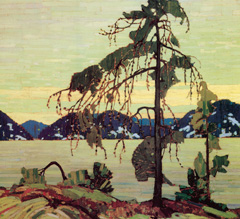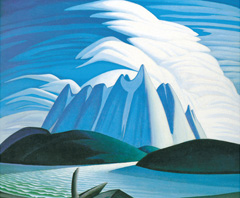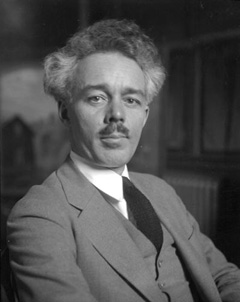|
| THE GROUP OF SEVEN |
 |
SUMMARY
The Group of Seven was Canada's first art movement, responsible for countless internationally renowned paintings of the Canadian wilderness. The works raised awareness of and appreciation for the nation's uninhabited landscapes, which make up about ninety percent of the country, as well the existence of a real artistic talent within the northern borders. The work of this talented group is still much sought-after today, and originals and prints are shown in major museums and galleries across Canada.
Inspired by an exhibit in New York of Scandinavian landscape paintings, two founding members, J.E.H. MacDonald and Lawren Harris, returned home eager to form a collective of artists whose passion for Canada's own beauty could be seen and felt within their art.
The original seven members, and the others who came later, were gathered from all over Canada, and beyond. In 1914, the Studio Building was erected to serve as the meeting place for the new movement, though the true studio was the natural landscape, which they regularly visited and sketched.
Though various members came and went, and events such as World War I separated the Group of Seven, each member was encouraged and inspired by the others. To this day, the brilliance of Canadian lakes, mountain ranges and forests can be felt through the work of these groundbreaking artists.
|

Jack Pine, T. Thomson, 1916 |

Lake and Mountains, L. Harris, 1928 |

Tangled Garden, J.E.H. MacDonald, 1916 |

Mirror Lake, F. Carmichael, 1929 |

The Red Maple, A.Y. Jackson, 1914 |

The Guide's Home Algonquin, A. Lismer, 1914
|

Stormy Weather Georgian Bay, F. Varley, 1921 |
|
| THE STORY BEHIND THE GROUP OF SEVEN |
 |
THE INSPIRATION
The founding members of The Group of Seven met by happenstance. Five of the them (Lismer, Carmichael, Johnson, Varley, and MacDonald) worked together at a Toronto design firm shortly after the turn of the 20th century. United by their love of painting, the group began taking sketching trips together out of the city, and meet at clubs to discuss art and socialize.
Another well known Canadian artist, Tom Thompson, also worked at the firm and was initially a part of this close knit group. Though he passed away not long after, his work was very influential to the official formation of the group.
Around the time Jackson relocated to Toronto at Harris' request, some members of the group saw an exhibit of Scandinavian paintings that served as a major instigator in the development of their future style. It is fitting then, perhaps, that seven years later the seven founding members decided to exhibit together as the Group of Seven.
Though the name did not change, the seven founding members did expand their ranks. By the end of the movement, the group had grown to include three additional members: A.J. Casson (1926), Edwin Holgate (1930) and L.L. Fitzgerald (1932). West coast artist Emily Carr was also affiliated with the group, though she was never an official member. Frank Johnston, one of the original seven, resigned from the group after only one exhibit. Some combination of these ten men continued to exhibit as a group until 1931.
Though officially together for only slightly more than a decade, the influence of the Group of Seven was great, and remains so. Their influence can be seen in the work of their contemporaries, such as David Milne, J.W. Morrice, and Thoreau MacDonald. The Canadian Group of Painters, who began working together in the 1930s, were something of a continuation of the original group.
THEIR UNIQUE STYLE
The members of the Group of Seven felt the best depictions of nature came from spending time within it (painting or sketching "en plein air"). Preferring to develop their own style rather than follow in the footprints of European contemporaries and traditions, the group chose to depict their subject matter with bold, bright colour. They brought to life the wild weather and multitude of lakes and rivers that are part of Canada's national identity.
THE ARTWORKS TODAY
The last of the original members passed away in the 1970s, but their work lives on. Group of Seven paintings are still extremely popular, and can be seen in many celebrated Canadian art galleries and museums including The Art Gallery of Canada, the Art Gallery of Ontario, and the McMichael Canadian Art Collection. Each year, original paintings and sketches sell to private collections for hundreds of thousands of dollars.
Lists of the most expensive Canadian paintings always include works by members of the Group. Among these highly valued and much loved pieces are Lawren Harris' The Old Stump, Lake Superior ($5.1 million) and Houses, St. Patrick Street ($2.8 million), and Tom Thomson's Early Spring, Canoe Lake ($3.5 million).
REPRODUCTIONS
Not surprisingly, given their popularity, many Canadian print shops provide reproductions of Group of Seven works on posters, fine art paper and canvas. Some even offer hand painted reproductions. Due to artistic copyright restrictions, proper permissions must be purchased in order to recreate works for which the copyright has not yet expired.
|
| LAWREN HARRIS |
 |

Lawren Harris, 1926 |
1885-1970
Born into a wealthy Ontario family, Lawren Harris was allotted plenty of time to practice his passion. After studying philosophy and Eastern thought for three years in Germany as a young man, Harris returned to Canada to serve in the military. Following his discharge, he became acquainted with the other founding members of the Group of Seven, and made the first of many trips to Algoma in south eastern Ontario.
In the 1920s these trips, along with visits to Lake Superior's North Shore, defined the style for which Harris most recognized - simplified blocks of colour with an Aboriginal art influence, that utilized a thick, "impasto" application of paint. These are the works he exhibited with the Group of Seven.
Later in life, Harris moved with his second wife to Vancouver, British Columbia, where his work took a more abstract turn. Despite the lack of realistic representation, the influence of the land was still evident in his late work.
|
| J.E.H. MACDONALD |
 |

J.E.H. MacDonald, 1930 |
1873-1932
One of three members of the Group who was not born in Canada, James Edward Hervey MacDonald spent his youth in England and emigrated to Canada with his family in 1887. Then fourteen, MacDonald began training at the Hamilton (Ontario) Art School. Two years later they moved again to Toronto, and MacDonald attended the Central Ontario School of Art and Design.
He began working at the fateful Grip Ltd in 1895, where he encouraged colleagues such as Tom Thomson to develop their skills. Though he left the firm in 1911 to pursue freelance design, he produced a solo exhibit in 1912, prompting Lawren Harris to encourage him to begin painting full time. It was with Harris that MacDonald viewed the New York exhibit of Scandinavian art that inspired them to artistically celebrate the landscape of their own country.
In 1928, MacDonald became the Principal of the Ontario College of Art, where he remained until his death. His paintings have been praised for their strong command of colour, and images of the rugged Algoma country where he and the other group members would often paint are considered his most accomplished works.
|
| FRANKLIN CARMICHAEL |
 |

Franklin Carmichael, 1930
|
1890-1945
Franklin Carmichael was born to a carriage maker in Orilla, Ontario. At the age of twenty, Carmichael enrolled in the Ontario College of Art in Toronto, where he studied with famous artists George Reid and William Cruikshank. Following his education, Carmichael joined the design firm Grip Ltd, where he met Tom Thomson, as well as four other founding members of the Group of Seven.
Though he joined the others on their Algoma sketching trips and was greatly influenced by Thomson's work, Carmichael felt separated from the other artists - he was the youngest member - and in fact grew closer to the later additions to the group. After exhibiting in the first Group of Seven show in May of 1920, Carmichael disengaged to pursue other avenues.
One of the co-founders of the Ontario Society of Painters in Watercolour (1925), Carmichael was also instrumental in founding the Canadian Group of Painters, which came together in 1933 and was joined by other former Group of Seven members.
|
| A.Y. JACKSON |
 |

A.Y. Jackson, 1943 |
1882-1974
As a child, A.Y. Jackson worked at a lithograph company in Montreal, Quebec to help support his family. This experience helped shape his art training, and he began taking art classes in the evenings. After travelling first to Europe, Jackson studied at the Art Institute of Chicago and then studied Impressionism in France, even having a work accepted in the Paris Salon. After returning to Canada in 1912, another of his works was purchased by the National Gallery.
Just one year after his return home, Harris and MacDonald viewed Jackson's work and the three began corresponding, with Jackson even joining some of the future Group of Seven on excursions to Algoma and other Ontario locations to paint. Eventually, Jackson agreed to move to Toronto to join the group.
Prior to the official forming of the Group in 1919 (just before their first exhibit), Jackson enlisted in the Canadian Army. He ended up becoming a war painter for two year years, after which he returned to Toronto.
Following his work with the Group of Seven, Jackson continued to create art and take group painting trips. In 1954, he was commissioned to paint a mural for the Canadian Pacific Railway, and in 1958, he published an autobiography which he dedicated to J.E.H. MacDonald.
|
| FRANK (FRANZ) JOHNSTON |
 |

Franz (Frank) Johnston, 1930 |
1888-1949
A native of Toronto, Ontario, Francis Johnston was a short-lived member of the Group of Seven, but nevertheless closely involved in its inception. Another employee of the design firm where many of the members met, Johnston accompanied MacDonald and the others on many of their painting trips. Soon after exhibiting at the first Group of Seven show, however, Johnston departed to become take an administrative position at the Winnipeg School of Art. In the late 1920s, he changed his name from Frank to Franz.
Over the years, Johnston's work shifted from a decorative depiction of the landscape to a more realistic interpretation, focusing heavily on the effect of light on the scene. He painted areas of Northern Quebec, as well as the Northwest Territories and Ontario. It is estimated he created more than 250 paintings over the course of his career.
|
| ARTHUR LISMER |
 |

Arthur Lismer, 1930 |
1885-1969
The second member of the Group of Seven who was not born in Canada, Arthur Lismer grew up in Sheffield, England. He worked at a photo engraving company at a young age, and received a scholarship which he used to study in the evenings at the Sheffield School of Arts. In 1905, he relocated to Belgium to study at the Academie Royale.
After immigrating to Canada in 1911, Lismer settled in Toronto and joined the very design company at which many of his future associates worked. In between the paintings trips, on which he joined the others, and the official formation of the Group however, Lismer served as the President of what is now the Nova Scotia College of Art and Design. Living in Halifax, Nova Scotia during World War I, he was commissioned as an official war artist.
Lismer's companionship with the Group of Seven was clear in his passionate, organic depictions of the Canadian landscape. Following the Group's dissolution, Lismer was one four members who joined the Canadian Group of Painters. He continued to paint throughout his life, and was made a member of the Royal Canadian Academy of Arts and a Companion of the Order of Canada.
|
| FREDERICK VARLEY |
 |

Frederick Varley, 1926 |
1881-1969
Born in Sheffield, England, Frederick Varley studied art both in his hometown and later at the Academie Royale in Belgium. In 1912 at the encouragement of his friend Arthur Lismer, Varley emigrated to Canada and was hired at Grip Ltd.
Varley served as an official war artist in 1918. Though he continued to paint landscapes, this experience drew him to depictions of the human form. One of the few members to paint portraits, Varley was also interested in depicting landscapes ravaged by fire - perhaps a vestige of his time as a war artist.
In 1926, Varley relocated to Vancouver, British Columbia to teach at the Vancouver School of Decorative and Applied Arts, where he again took up landscape painting in oil and watercolour. He returned to Ontario during the Depression, and remained there for the most part for the remainder of his life.
|
| The Group of Seven is widely credited with bringing Canadian painters and the Canadian landscape to the attention of Canada itself, as well as the rest of the world. Today, when one is asked about Canadian art, the icy mountain ranges of Lawren Harris, or the autumnal trees of A.Y. Jackson and Tom Thomson immediately spring to mind. That their work remains such an iconic part of Canadian heritage after nearly a century is testament to their talent and the success of their ambitious dream.
|
|

